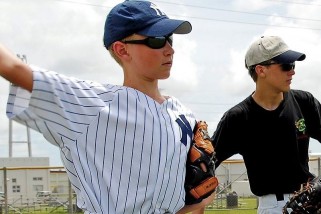BreakingModern — So here’s a new approach to dating. Instant Chemistry and SingldOut are now offering the first direct-to-consumer dating website that analyzes users’ DNA to identify romantic compatibility. In short: Genetic dating. Saliva-based DNA services like 23andMe are not new, but SingldOut takes the “spit, seal and mail” approach to new heights. They suss out known genetic factors that are linked to attraction.
Welcome to love in the biotechnological age, where you don’t need a wingman, but a geneticist.
Here’s how it works: You sign up and get mailed a package, you spit into a cup, then you FedEx your spit test back to the Instant Chemistry lab. The results are analyzed and your genetically-approved dating prospects are accessible online.
“This science of why two people are attracted to each other is based on 20 years of research on the immune system and pheromones and what attracts two people together,” Jana Bayad, CEO and cofounder of SingldOut, told Business Insider. “We’re taking that data to bring it to online dating. We’re adding the biological factor because we know that we can determine whether two people will be attracted to each other or not.”
Can dating be broken down scientifically?
Not all scientists are lauding the new service. Though the Instant Chemistry team is comprised of an impressive roster of Ph.Ds — among them are biologists, geneticists and neuroscientists — other academics may find themselves rolling their eyes.
“The idea of basing a dating website or service on a handful of genes is absurd. Using the science in this way takes advantage of people who do not know anything about human genetics,” says Ricki Lewis, PhD, author of “Human Genetics: Concepts and Applications” in an interview with Healthline.
“Testing for two genes out of 20,000 … is hardly useful — would you select a person to date based on four items on a 20,000 item questionnaire?” Lewis asked. “Even if what those two genes do makes sense, it is simply too little information to have any value. I think a shared love of pistachio ice cream or running or Woody Allen films may be more meaningful measures of day-to-day compatibility.”
There are plenty of studies that link genetics with attraction. You’ve probably heard of the famous 1995 study in which single women were asked to sniff sweaters that had been previously worn by men. As it turned out, women favored odors from sweaters that were worn by men with different MHC alleles than their own.
But MHC alone is not singularly responsible for attraction. Even when tested among a handful of other genetic factors, the efficacy of such a limited analysis has yet to be determined.
Another shortcoming: one of Instant Chemistry’s DNA analyses singles out three specific genes in the MHC complex on chromosome six. But research regarding the predictability of MHC-correlated mate choice is conflicting. There’s a leading hypothesis that “disassortative” mating will produce offspring with greater diversity in their MHC genes that will protect them against a broader range of pathogens, according to Gary Marchant and Yvonne Stevens for Slate. But the research hardly points in one direction — some studies support the disassortative hypothesis, while others do not.
Given the complexities that influence attraction — only some of which are genetic — a saliva-based DNA dating service seems premature. A spit test isn’t necessarily going to unequivocally demystify romance anytime soon, but it’s an interesting step toward supporting the growing understanding of how biology influences romance and attraction.
The good news is that humans have been getting it on and reproducing without any “spit, seal and mail” DNA gimmicks for 200,000 years. Trying the spit test could be fun, I guess, but finding a suitable mate using the old-fashioned instinct feeling isn’t so bad. And, hey, it’s free.
For BMod, I’m Raquel Cool.
Image Credits: InstantChemistry.com







![Pete Rose Continues to be Out of Step with Major League Baseball [commentary]](../wp-content/uploads/2015/10/HEADER2-321x214.png)



![The Legend of Zelda: The Wind Waker HD [review]](../wp-content/uploads/2015/10/HEADER-321x214.jpg)
![Madden NFL Mobile [review]](../wp-content/uploads/2015/09/header3-60x60.jpg)

![Call of Juarez: Bound in Blood [review]](../wp-content/uploads/2015/09/HEADER--60x60.jpg)
![Command & Conquer: Red Alert 3 [review]](../wp-content/uploads/2015/09/HEADER-60x60.jpg)